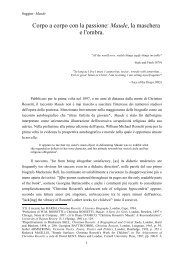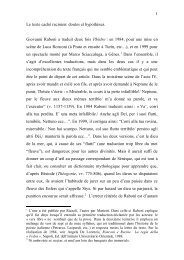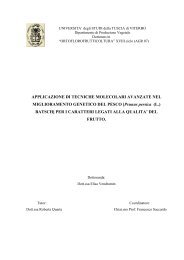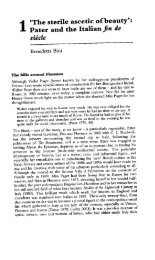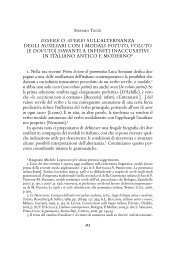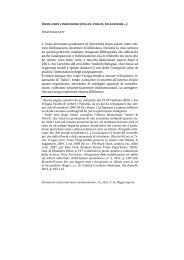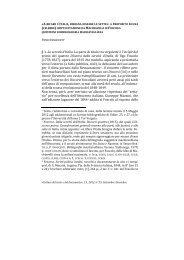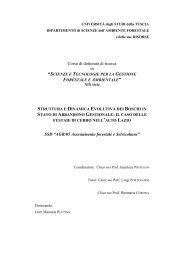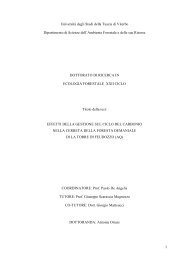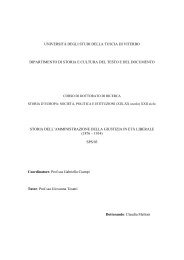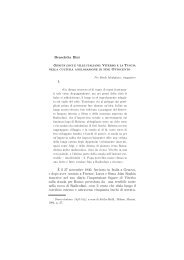drivers of soil respiration of root and microbial ... - Unitus DSpace
drivers of soil respiration of root and microbial ... - Unitus DSpace
drivers of soil respiration of root and microbial ... - Unitus DSpace
Create successful ePaper yourself
Turn your PDF publications into a flip-book with our unique Google optimized e-Paper software.
6.4. Discussion<br />
6.4.1. Mesh-exclusion<br />
158<br />
Mesh-exclusion technique is a type <strong>of</strong> widely used <strong>root</strong> exclusion methods. Such type <strong>of</strong><br />
partitioning methods potentially changes <strong>soil</strong> nutrient <strong>and</strong> water status <strong>and</strong> in combination with a<br />
lack <strong>of</strong> competition with <strong>root</strong>s <strong>and</strong> mycorrhiza could alter <strong>microbial</strong> <strong>respiration</strong> <strong>of</strong> SOM <strong>and</strong> litter in<br />
the <strong>root</strong> free <strong>soil</strong>. Because <strong>of</strong> the absence <strong>of</strong> <strong>root</strong> exudates in the <strong>soil</strong> core it is not possible also to<br />
account for any priming effect, which is usually appears to be under the natural <strong>soil</strong> conditions<br />
(Kuzyakov, 2002; Kuzyakov <strong>and</strong> Bol, 2005; Kuzyakov, 2006). The modification <strong>of</strong> the method <strong>and</strong><br />
introduction <strong>of</strong> the nylon mesh bags with various apertures seems promising, allowing the flow <strong>of</strong><br />
water <strong>and</strong> dissolved substances through the mesh, thus minimizing the disturbance <strong>of</strong> natural <strong>soil</strong><br />
environment.<br />
However, there are some particular shortcoming <strong>and</strong> limitation associated with the utilized<br />
methodology, which result in a possible overestimation <strong>of</strong> <strong>microbial</strong>-derived <strong>respiration</strong> <strong>and</strong><br />
underestimation <strong>of</strong> <strong>root</strong>-derived one.<br />
Namely, the shortcomings <strong>of</strong> the method are: disturbance <strong>of</strong> the <strong>soil</strong> structure by sieving<br />
<strong>and</strong> lateral diffusion <strong>of</strong> CO2 (Jassal <strong>and</strong> Black, 2006; Moyano et al., 2008) to the mesh bags from<br />
the surrounding <strong>soil</strong> <strong>and</strong> inability to separate <strong>root</strong> <strong>respiration</strong> from rhizo<strong>microbial</strong> one.<br />
We tried to minimise the effect <strong>of</strong> the <strong>soil</strong> disturbance on <strong>microbial</strong> activity <strong>and</strong> <strong>respiration</strong><br />
fluxes by installing an additional mesh <strong>of</strong> 1cm, <strong>and</strong> obtaining the value <strong>of</strong> <strong>root</strong>-derived <strong>respiration</strong><br />
as a difference between two meshes with the equally disturbed <strong>soil</strong>. However, here we make an<br />
assumption that there is no difference in the in-growth patterns <strong>of</strong> <strong>root</strong>s between non disturbed <strong>soil</strong><br />
<strong>and</strong> <strong>soil</strong> which was previously sieved. Microbial-derived <strong>respiration</strong> was calculated further from the<br />
difference between control (non disturbed <strong>soil</strong>) plots <strong>and</strong> <strong>root</strong> <strong>respiration</strong>.<br />
Presence <strong>of</strong> the CO2 from the surrounding <strong>soil</strong> in the mesh bags by its lateral diffusion<br />
through the <strong>soil</strong> pores was confirmed by the pulse labeling <strong>of</strong> the adjacent <strong>soil</strong> in 13 CO2 atmosphere<br />
<strong>and</strong> its tracing in the 13 CO2 respired from the mesh bags. The magnitude <strong>of</strong> the influence <strong>of</strong> the<br />
lateral CO2 on the <strong>respiration</strong> rate is however difficult to estimate. Moyano et al. (2008) reported a<br />
value <strong>of</strong> ca. 10%, obtained by inserting a PVC tubes over the mesh <strong>soil</strong> cores. As the procedure is<br />
associated with additional disturbance <strong>of</strong> the measurement plots we preferred to avoid it. Presence<br />
<strong>of</strong> laterally diffused CO2 results in a systematic overestimation <strong>of</strong> the <strong>microbial</strong>-derived<br />
<strong>respiration</strong>. Here we make a second assumption: the influence <strong>of</strong> the lateral flow <strong>of</strong> CO2 is constant<br />
during the growing season, <strong>and</strong> doesn’ t modify the seasonal trend in contribution <strong>of</strong> <strong>soil</strong><br />
<strong>respiration</strong> components to the total one. We also argue that an introduction <strong>of</strong> the additional 1 cm<br />
mesh core with the same influence <strong>of</strong> the incoming CO2 from the surrounding <strong>soil</strong> could potentially<br />
minimize the error in estimation <strong>of</strong> <strong>root</strong>-derived <strong>respiration</strong>.




